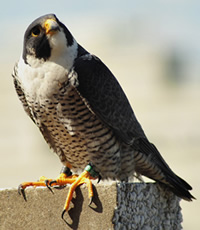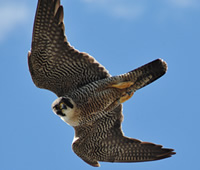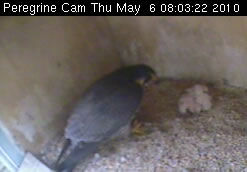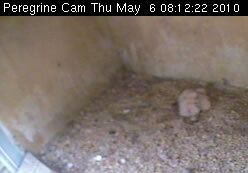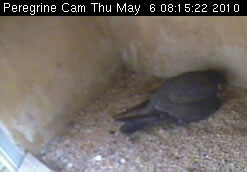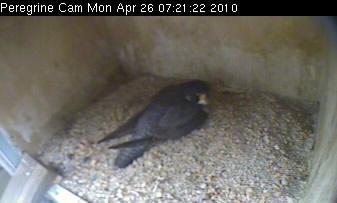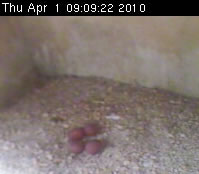2010 Peregrine Nestbox News
Nestbox News is an account of activity at a nestbox atop Mack-Cali Realty Corporation's 101 Hudson, Jersey City, by biologists in the Endangered and Nongame Species Program (ENSP). Follow this chronicle of the nesting behavior and activity of peregrine falcons and their chicks. We encourage viewers to help support the webcam and all the work of the ENSP through the Income Tax Check-off for Wildlife and Conserve Wildlife License Plates. We appreciate and value your support, as well as the support we've received from the Conserve Wildlife Foundation of NJ and the Mack-Cali Realty Corporation staff at 101 Hudson - without their cooperation the nestbox and webcam would not be possible. To view the live feed or still images follow the links from the webcam homepage.
November 3, 2010: Release of Falcon 00/AE
Oftentimes, a bird with this injury cannot be released back into the wild. However, thanks to the dedicated efforts of the staff at The Raptor Trust and the strong make-up of a peregrine, 00/AE was released back in Jersey City late last week. We wish her well as she has already left the area, perhaps to turn up as a breeding adult elsewhere along the East Coast.
On July 13, biologist Kathy Clark investigated the report of a previously-unknown peregrine falcon nest in Paulsboro (Gloucester Co.), on the site of the Valero Refinery close to the Delaware River. It is indeed a peregrine nest, and staff and contractors have been keeping an eye on the pair. They alerted ENSP when the one nestling fell out of the nest on the day before, and got the young one off the ground onto a platform about 12’ up where the adults could continue to care for it. We banded the single nestling yesterday, and got photos of both adults. The female is unbanded, but the male is *8/*W (black/red), originally banded at 101 Hudson Street in 2003! As you can see from the photo he has matured into a handsome bird. A nest with a 3-week old chick at this time in the summer suggests this pair failed in their first nest attempt, but re-laid and have late-season success. (Coincidentally, 2003 was the year the first clutch of eggs was lost under an 8" snowfall!) Reports are that this nest site has been active, with varying success, since 2007. Now that we know about it, we can keep tabs on them and add them to the figures on annual nesting and productivity statewide. We also add to the Jersey City alumni list!
July 19, 2010: Report on 00/AE
It will take 6-7 weeks to learn if she can be released. Until, then, the care she'll receive at The Raptor Trust is the best available - if any facility can rehab a peregrine for release it is this one. The Raptor Trust is a private, non-profit, tax-exempt corporation and relies on contributions for its day-to-day functioning. It receives no government funding. Those interested in making a monetary or non-monetary donation should visit www.theraptortrust.org/donations/. We'll update Nestbox News about any changes in OO/AE's condition, or any milestones we're informed of.
July 15, 2010: Update on 00/AE
July 14, 2010
Mike agreed to help, but couldn't get there til Thursday. Then, at 7:25, security called again to inquire if anyone was coming - the tide was coming in fast! We didn't realize the bird was in the tide zone, and our concern was heightened - there was no way we could get anyone there before the tide came in and/or darkness fell. Fortunately, the staff at Spartan Security (which also handles security at 101 Hudson St.) also had contacted the Jersey City Animal Control office. We were contacted again by Spartan Security at 8:45 that the they had been able to respond and had the bird. The bird was transported to The Raptor Trust this morning by Jersey City Animal Control. We've learned that it is 00/AE, one of the fledglings but not the one they had in before. They reported bird looks alert and is not thin, but they hadn't had a chance to do the full exam yet. They do anticipate keeping it through Sunday to get x-rays on that day. Hopefully she'll check out fine and we'll release her back in Jersey City relatively soon. This is not the first time we've had help with our Jersey City falcons from Spartan Security and the city, and we would like to thank them for helping with the recovery of the state's, and region's, peregrine population.
July 8, 2010 (from Mike Girone)
Today was the 4th time in a row I've seen a fledgling perched in the same spot on Plaza 5, and 3rd time in the last 4 trips that one has been on the Trump building. I'm starting to wonder if it's the same fledgling and which one it might be. Maybe, since 03/AE's flying skills were somewhat behind her sisters due to her absence, she is sticking close to home longer then the others. Perhaps the others have already spread out of the neighborhood and are getting hunting lessons from the adult male. Things definitely quieted down in that area quickly this year, especially compared to last year (we still saw the fledglings almost 6 weeks after fledging, this year it seems like half that time). I know this year's group all fledged somewhat early. According to biologist Kathy Clark, the heat may have something to do with their activity levels. They might be more active early in the morning and late afternoon. Kathy notes that, in general, the fledglings need adult support for 4-6 weeks after fledging. We hope they are still around their parents, just going undetected, especially mid-day.
July 6, 2010 (from Mike Girone)
At 8:30, Bonnie spotted a peregrine flying over Plaza 5 and Plaza 4A. A few minutes later, she spotted a fledgling eating on the top SW corner of Plaza 5. She ate for about 10-15 minutes, then flew over to the Trump tower on Washington St. 1 block NW of Plaza 5. She landed on a SW corner ledge about 5 floors from the top of the building. She was preening and laying down on the ledge for quite a while. I briefly saw the adult male perched back at 101 Hudson on a 39th floor ledge, around the corner from the brackets. I took a walk south along the river, then north on Hudson St. to try to spot any other falcons, but no one else was around. When I returned to Pearl St., the fledgling and adult male had flown off. I went back down on the morning of the 4th from 8:20 - 11:30 a.m. on the corner of Pearl & Greene. When I arrived, I saw a fledgling perched on the ledge of the 2nd tier at Exchange Place, west side. I watched her preening and doing lots of wing, leg, and tail stretching. She walked quickly back and forth on the ledge a few times, looking in at the roof and bobbing her head. There may have been another fledgling on the roof that had her attention, but I didn't see any others. She stayed on the ledge for almost 90 minutes, then at 9:47 a.m., she took off heading north over Hudson St., going behind Plaza 5. I didn't observe any peregrines afterward. The fledglings this year definitely seem less inclined to stay local as long as last year's pair did!
June 28, 2010: Fledgling Watch Continues
On Sunday, they documented a lot of flying action by all the birds, and the adults bringing in prey for the young. They did not see all four fledglings together at once either day. Considering the group has been seen on up to four buildings other than 101 Hudson, it may just be unlikely for all four to be visible from any 1 spot at a given time. It’s likely they have seen all four, but definitely saw two fledglings together several times, and saw one that seemed to have trouble finding the ledges at 101 Hudson, which may have been the recent returnee (03/AE) trying to re-familiarize herself with the building.
June 25, 2010: Release of Fledgling 03/AE
Bonnie & I picked up the injured female fledgling 03/AE this morning at The Raptor Trust around 9:30 a.m. She was moving around in the box for a few minutes, but calmed down quickly. We got to the top of 101 Hudson by 10:30 a.m., opened the door to the roof area, and placed the box just outside the door. The top was opened and out came the fledgling! She immediately took off, flying north out over Montgomery St., then turned west and south, flying around the west side of 101 Hudson. She flew strong and confidently! Almost immediately afterward, the adult male came in from the east and landed on the nestbox parapet. We took the cardboard box and closed the roof door. Fellow peregrine volunteer watcher Ray was on the corner of Greene & Pearl watching the release, and reported the adult male staying on the box parapet, with the adult female on the very top NW corner parapet, in addition to the fledgling’s very good flying. Following the release of 03/AE, we joined Ray street-side. After the adult male took off to go hunt, 2-3 fledglings were spotted flying, and 2 nearly made it as far as Pearl St over Plaza 4A. Two fledglings landed on the top NW corner ledge at 101 Hudson. After a few minutes, 1 went down to roof. The adult female landed on the west bracket on the 39th floor and preened. A fledgling was on a nearby ledge to the right, looking down at the roof and hopping on and off the ledge. We stopped at Plaza 4A before leaving. The adult female finished her preening before taking off from the bracket. The fledgling on the nearby ledge continued preening. A fledgling was spotted on the top NW corner ledge near a satellite dish. At 12:30 p.m., the adult male returned with prey. The fledgling on the top ledge took off after him, and there was an aerial prey-exchange! The adult male flew west back on the hunt, and the fledgling carried the prey back to the top floor ledge. She mantled over it for a few minutes, then began eating. She dropped down to the ledge right before we left. We couldn’t see all 4 fledglings together at once, so it’s hard to say if she was one of the fliers we watched from the street. Thanks to observations from peregrine watchers Wayne & Else, we know that her 3 sisters were all on the wing by the evening of June 16th. 03/AE is a little over a week behind, but the strength and fluidity of her flight upon release is extremely encouraging, and suggests she will catch up quickly! See Bonnie's video at www.youtube.com/watch?v=8QD9TytH4qg.
June 21, 2010
Bonnie & I were downtown Saturday morning from 8 a.m. to 12:30 p.m., and Sunday morning from 8:30 a.m. to 11:00 a.m. Most of the observing was done from the corner of Greene & Pearl and Plaza 4A. On Saturday, we quickly located all 5 falcons: adult male on the 37th floor ledge, adult female on a parapet in the middle of the top level of 101 Hudson. 2 young were on the 41st floor ledge just west of the box, and the 3rd one was on a top-level parapet on the NE corner of 101. (The fourth fledgling is still at the The Raptor Trust.)
The male returned with prey at 9:50 a.m., landing on the 41st floor ledge east of box, with the adult female landing next to him and taking prey. The male left, and the female took the prey to a lower NE corner parapet to de-feather it. The 2 young on the NW corner ledge hopped over to the box’s roof area, wailing at the adult. She delivered prey to the fledgling on the top parapet, who immediately mantled over it for at least 5 minutes. The adult female went down to the west bracket on the 39th floor, north side of 101 Hudson. Around 10:05 a.m., she flew out to the top of Exchange Place tower. At 10:15 a.m., a young one hopped up to the top of a parapet east of the box, then took off flying around the west side of 101 Hudson, turned around, and flew back to another parapet in the same area. She hopped down to the roof, then a few minutes later flew up to the top ledge, next to the parapet where the first fledgling was perched. Meanwhile, the male came in and perched on a parapet on the west side of 101 Hudson, around the 36th floor. At 10:52 a.m., the adult female returned to 101, landing on the west bracket on 39th floor. She then flew up to the top NW parapet. At 11:40 a.m., the young one that had been on the NW corner ledge took off, taking a flight around the west side of 101 and over the top, then chased the adult female off the top NW parapet and took her place there. A few minutes later, she took a short flight east along the top of 101, joining her 2 sisters on the top ledge. The male took off flying rapidly NW on the hunt, while the adult female returned to the top of Exchange Place tower. From 11:50 a.m. to 12:00 p.m., the 2 fledglings that had been on the 41st floor earlier in the morning took off flying together and chasing each other around the west and south sides of 101 Hudson. They separated and spread out, reaching nearly 2 blocks both NW and North of 101 Hudson. Upon return, one landed on the box parapet, another landed on a 38th floor parapet on the NW corner. One flew back up to a top-level parapet, the other dropped down to the roof. The male was briefly seen gliding and soaring over the Columbus & Hudson intersection before drifting south. The adult female was out of view by this time. Sunday morning was all quiet until 9:23 a.m. when 2 fledglings flew out to the east of 101 Hudson and swept around to the south side. The male appeared on a west-side parapet on the 39th floor, looking NW. At 9:35 a.m. there were suddenly 4 falcons in the air: all 3 fledglings and the adult female. The adult landed on the parapet at the far NE corner of the box’s roof-top area of the 41st floor. 2 of the fledglings landed on the far eastern parapet on the 39th floor, east of the brackets. They each hopped down to that floor’s roof. One re-appeared twice on the ledge. At 9:56 a.m., it took off for a lengthy flight, making 2 trips around the top floors of 101 Hudson. She eventually landed on top of the parapet just east of the box. The birds went quiet and out of view after this time, with just brief sightings of male on west-side parapet on 39th floor, and a fledgling briefly on the top NW corner parapet. The fledglings are flying very well already, can stay aloft for several minutes at a time, and make fairly controlled landings on the ledges and parapets! It’s amazing to see how quickly they gain their flight strength and confidence!
June 16, 2010
I visited Jersey City today (Tuesday, June 15) from 10:30 a.m. to 1:30 p.m. on the corner of Washington St. & Columbus Ave. As soon as I set-up, I saw a juvenile flying around the western side of 101 Hudson (probably the one that fledged on Sunday). She did a lot of flapping but also some fairly controlled glides and even a brief hover above the box. She then landed on the 41st floor roof in the area of the box. Both adults were on parapets next to and just west of the box, looking down at the 2 roof areas. Both adults at times flew north on the hunt, but came back empty-taloned. From 11:30 a.m. to 1:30 p.m. I occasionally saw a juvenile hopping up to the 41st floor ledge east of the box. I don’t know if it was the flier each time, or if it was one of the other juveniles. I never saw more then one bird at any one time. The adults were keeping an eye on the roof area where all 3 were perched on Saturday, so I think at least one was on that roof and just out of view while I was there. The adults did swoop by that area a few times in what looked like an attempt to get someone up and flying. At noon, both adults took off and began soaring over and north of 101 Hudson. While watching them, I spotted a 3rd peregrine very high up and flying from east to west steadily and without stopping. The adults stayed in the air for several minutes but didn’t attempt to go up to the intruder. After a few minutes they settled down and landed back on 101. The Sunday fledgling seems to be doing quite well and quickly learning how to use her wings. Wish I had seen all 3, but the parents were watching the 2 roof areas, so I think they were just not visible from the street (or it could‘ve been different juveniles hopping up on the ledge). I will be back down Thursday morning.
June 15, 2010
June 10, 2010: Nearly Fledglings
The fourth nestling, as we discovered, had become a reluctant fledgling! Workers in a company on the 37th floor called us to report they were watching one of the youngsters outside their window. Peregrine project volunteer Mike Girone was able to get there to check it out. It appeared that the young falcon was uninjured, but had left the 41st floor a little too early with wings not yet ready for flight. She probably sailed down to land four floors below on a small roof. (One of the great aspects of 101 Hudson is a tiered design from the top down, with platform roofs where young falcons can make a relatively safe, temporary landing.) Mike reported that the young bird was being watched over by the adult male who had already supplied food (a pigeon) for the wayward bird. So that explains the presence of just three young falcons in the box yesterday. At 5½ weeks of age, these birds are just days away from testing their wings. We certainly are hoping they will be in no rush to leave the roof. As they approach the 6-7 week age, their still-growing feathers will be that much stronger to support them in flight. Again we apologize for the difficulties in the streaming video from the roof at 101 Hudson. We are having trouble identifying the problem, but we’re all having it: the video starts up then cuts out after only a minute or two. We continue to look for the problems along the line.
June 7, 2010: Nestlings On the Move
We can hope to continue seeing peregrines in the camera views, but since they have a pretty large, flat roof to run and hop around, they may not often be in view. The adults will continue to feed them wherever they are on the roof, and that will continue for 6-8 weeks after the young take their first flights. As of Sunday afternoon, one nestling remained in the box, but decided to join the others around 5:30 PM. It’s normal for some to be less adventurous and this nestling may have been the last of the four to hatch and therefore a little behind the rest. They will probably remain outside the box, but the ramp is there should they want to go back inside during bad weather.
June 3, 2010: Banding in AC Video
May 25, 2010: Banding Day!
We switched the cameras so the live stream is from the "outside" camera. Though it is difficult to see into the box from that camera, the Still Images page will have the inside camera's view of the nestbox, allowing viewers to keep tabs on the chicks. We anticipate the chicks leaving the nestbox and exploring the roof in the next week or so - hopefully they will be on camera during their ventures.
May 21, 2010
Unfortunately, we are again experiencing a technical problem with the "outside" camera which was broadcasting a still image of the nestbox, often with an adult perched outside. We hope to fix the problem early next week when the biologists visit the nestbox to examine and band the chicks. Viewers should not be concerned if they tune in and see an empty box - the chicks will be returned as quickly as possible. After banding the next milestone will be when the birds fledge at 35 to 45 days after hatching (males earlier, females later). During that next phase of their development the young still remain dependent on the adults until they master their flight and hunting skills. Viewers who are interested in the development of peregrine chicks may wish to revisit the As Peregrine Chicks Grow page.
May 17, 2010: A Jersey City alumnus nesting in Connecticut!
A river and reservoir system lie at the base of the cliff where *V/*5 is nesting, so the nesting pair has an excellent territory for roosting, foraging, and breeding: an inaccessible cliff face, extensive open space, nearby bodies of water, and abundant food sources – especially pigeons. Park staff and volunteer Steve Broker are monitoring the nesting peregrines. *V/*5 has been nesting at this cliff site since 2009. Her mate is not banded. We will provide any more updates on this pair when we receive them from the folks in CT. It’s very exciting to see New Jersey peregrines contributing to the population recovery in natural habitats!
May 6, 2010
The images below, captured from the still images page, show the sequence at the nestbox as the female concludes the feeding session, leaves to dispose of the carcass, and then returns to brooding her young. Time of each image is in each photo heading.
We have hatchlings at Jersey City! Early this morning, 6:20 AM, there was one chick getting what may have been its first meal! At that time there were still three eggs that the chick was nestled within. The mom spent most of the morning keeping the eggs and chick warm, and by noon it appeared that all the eggs had hatched. Eggshell remnants can be seen in the nest but are soon removed by the adult and some are eaten to replenish the mother’s calcium. The hatchlings are slightly pink and very small, but do lift themselves up a little to take brief feedings. It’s an exciting time to see inside the nest. The adults are very careful around the young, both in feeding and brooding them, and the hatchlings are small but they grow fast. Stay tuned with us. We have hatchlings at Jersey City! Early this morning, 6:20 AM, there was one chick getting what may have been its first meal! At that time there were still three eggs that the chick was nestled within. The mom spent most of the morning keeping the eggs and chick warm, and by noon it appeared that all the eggs had hatched. Eggshell remnants can be seen in the nest but are soon removed by the adult and some are eaten to replenish the mother’s calcium. The hatchlings are slightly pink and very small, but do lift themselves up a little to take brief feedings. It’s an exciting time to see inside the nest. The adults are very careful around the young, both in feeding and brooding them, and the hatchlings are small but they grow fast. Stay tuned with us.
April 30, 2010 - 8:15 p.m.
April 30, 2010
April 26, 2010: Hatching expected May 2-3
Meanwhile, our dedicated falcons are continuing their patient incubation, now into their 26th day. We can expect hatching in about one week, around May 2 or 3. After that, the action will increase exponentially as all the adults’ attention will be directed at caring for chicks that grow very quickly. Biologists will check on the chicks when they are about 1 week of age, and will schedule banding for 3-4 weeks of age. Until then, thanks for watching!
April 1, 2010
Incubation typically takes 32-33 days of constant vigilance, keeping the eggs close to 98 degrees. During this time the female does most of the incubating, taking breaks only to eat and stretch while the male takes her place on the eggs. Hatching should occur during the first week of May. Viewers can do their part to support the work of the biologists by remembering to Check-off for Wildlife when completing their state tax forms.
March 29, 2010
Full incubation will not commence until the clutch of eggs is complete, that way the eggs will hatch very close together – on the same day or within two days – minimizing the size difference among nestlings. The eggs can withstand some chilling, just not freezing temperatures. On these chilly, rainy days, the adults will want to keep them covered and safe from the weather.
March 25, 2010
When we first tuned in today the webcam image revealed an egg that had been laid sometime between yesterday afternoon and 7:30 a.m. this morning. The timing is about average - egg laying varies year to year, with last year being one of the latest with the first egg not laid until April 13; in 2008 the first egg was laid around March 21. Hopefully a new egg will be laid every two days or so until there is a full clutch of three or four (rarely, five). Once the female has finished laying her eggs incubation will begin, and about 32 to 33 days later hatching should occur. We appreciate the support of all our viewers as we begin another season in earnest now that laying has begun. Please remember our work and Check-off for Wildlife when you complete your NJ tax form this year.
March 17, 2010
Staff made our initial trip to the top of 101 Hudson Street yesterday to restart the webcam system and begin another season of streaming live and still images over the Internet. We anticipate another exciting year observing the peregrine falcons using the nestbox maintained by the NJDEP Division of Fisha and Wildlife's Endangered and Nongame Species Program. The first nestbox was installed in 2001 and has fostered the successful fledging of young every year since (see the About the Peregrine Project page for a history of the project). Last year we installed a new box and changed its orientation to provide more protection from the elements. The move also required relocating the camera which now provides a better view of nesting activity. The webcam is now live in time to observe the laying and incubation of eggs in the coming weeks. As with so many things in the state and nation at this time, funding for projects such as this is becoming harder and harder to obtain - the Peregrine Project, like other projects conducted by the ENSP, is funded entirely by grants and donations. Please help this project continue by making a direct donation to the ENSP, or by "checking-off" for wildlife on your state income tax return. By becoming a partner in the work of ENSP you can proudly feel you are doing your part in protecting our endangered and threatened species. |
|||||||||||||||||||||||||||||
|
||
|
|
||
|
||
| |
||

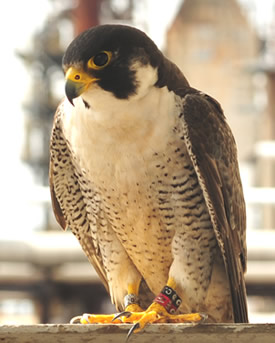 July 20, 2010: Another Jersey City Alumnus Located!
July 20, 2010: Another Jersey City Alumnus Located!
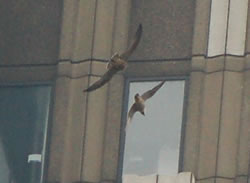
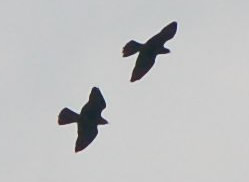
 At 9:35 a.m., the top NE corner fledgling flew west along the top of 101 Hudson, landing on 2nd to last parapet on that level. Adult female went down to the box parapet.
At 9:35 a.m., the top NE corner fledgling flew west along the top of 101 Hudson, landing on 2nd to last parapet on that level. Adult female went down to the box parapet.

